Description
Perfect Blu (135 pt)
No, I’m real!
perfect-blu.tar.gz 367b6ed67dda0afbbc975ee70ee946b4c7bf9268
Overview
Once I opened the downloaded .tar.gz file, I noticed there was a .iso file inside.
When I mounted it, I saw that it had a file structure that looked like fs structure of a DVD.
I then dragged this .iso file into VLC and got very surprised

As you have probably already figured out, this task is a DVD image with an interactive menu asking you to enter the flag.
Pressing the CHECK button shows either SUCCESS or WRONG... message, depending on the flag entered
Analysing
I’m gonna be completely honest, I’ve never had any experience with all this DVD stuff before, so I had to spend a couple of hours googling how to analyse this stuff first.
Apparently, there are multiple types of DVD menus:
- Java Menus
- IGS Menus
I first checked for any .jar files (or anything at all Java-related), but found nothing, which meant that I was dealing with IGS menu.
The first step in IGS menu analysis is to download BDEdit and open up our mounted BDMV\index.bdmv
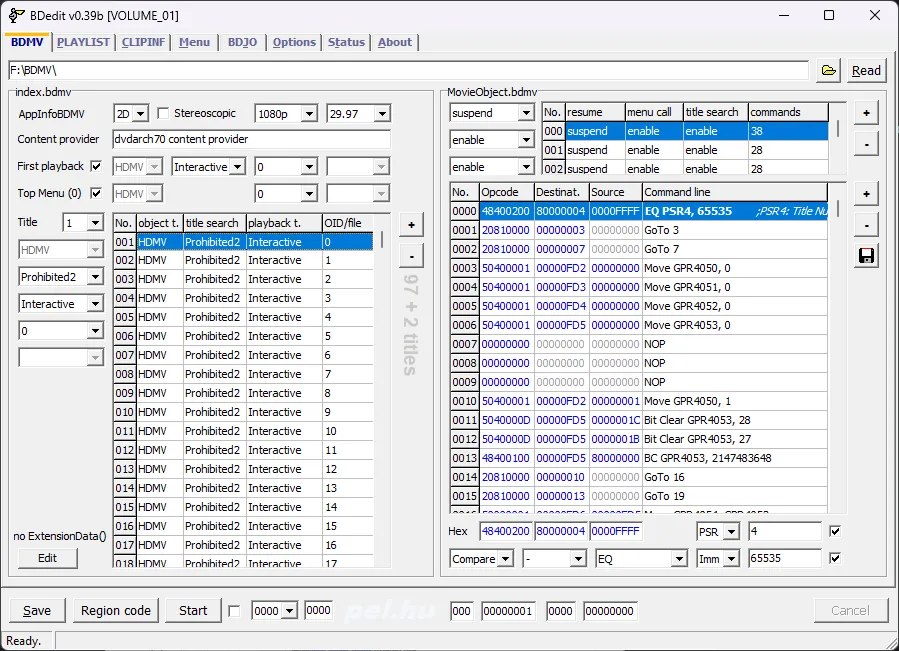
Looks scary. I know.
The first thing I did was to check the stream’s first clip information, looking for any bytecode or anything else of interest.
I did this by clicking on the CLIPINFO menu.
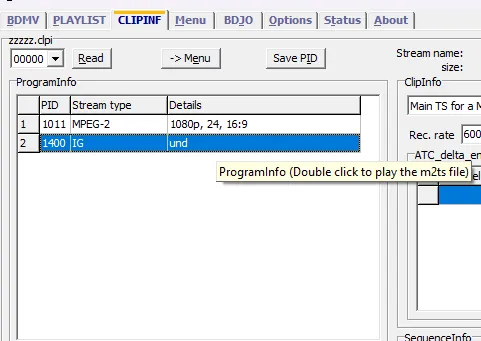
Here, at the top left corner, there’s a combo box with a clip selector. There are 96 clips and all of them have some buttons.
Within that menu, I reviewed each stream and identified the und stream which appeared to store the bytecode.
When I double-clicked on it, the menu with buttons opened up and I saw a lot of buttons and the disassembly of the code that they were doing:
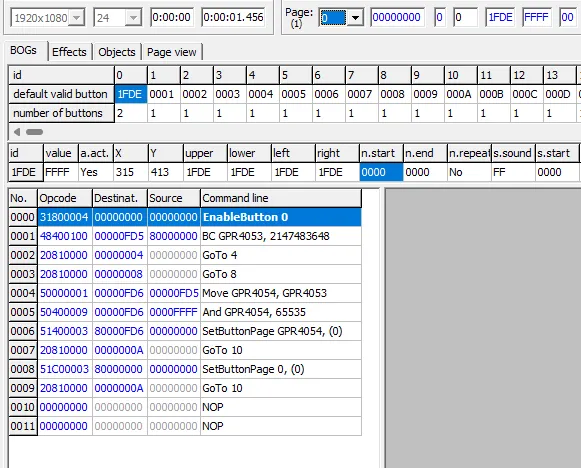
By messing around and guessing I found that the first default valid button (1FDE on the screenshot above) contains some random stuff I wasn’t interested in, which meant I should check others instead.

In this bytecode there’s a Call Object ** instruction (opcode 21820000).
This instruction simply starts playing another menu provided as its first operand.
Knowing this, I started analysing what the other buttons were doing.
By observing all the other buttons I saw three types of buttons.
JumpTo48 - Most buttons will take you from the current menu to menu 48.
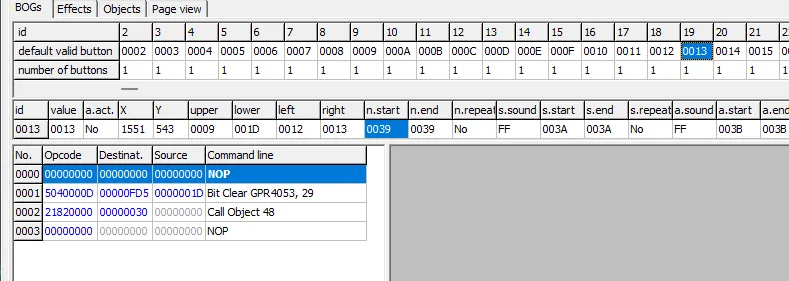
JumpTo1 - This button takes you from the current menu to menu 1.
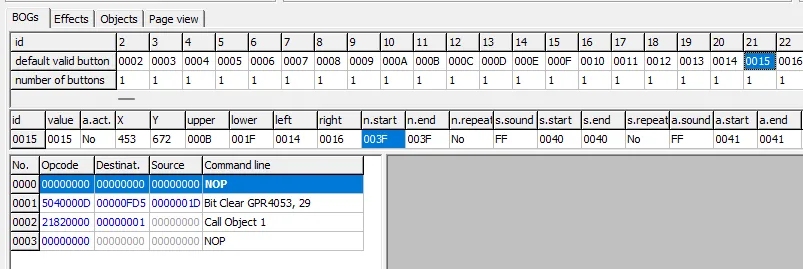
JumpTo96 - This button takes you from the current menu to menu 96.

Jumping from clip 0 to clip 96, huh? I checked the clip 96 by playing the BDMV\STREAM\00096.m2ts file in VLC and got this:
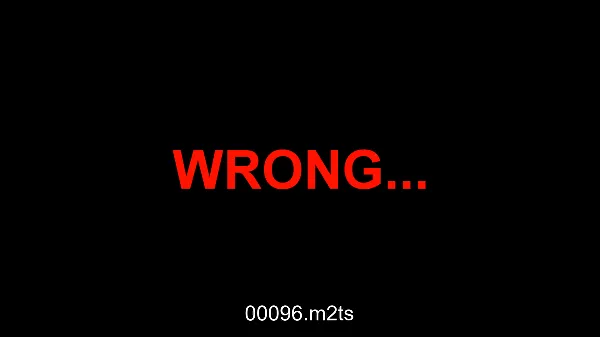
At this point, I knew that there were only three destinations in the first menu
- Clip 1
- Clip 48
- Clip 96 (
WRONG...)
When exploring other clips(1, 48) in VLC, all seemed to show the same controls prompting for the flag.
Let’s define this behavior as a pattern that we can then match with other menus:
- Jump to
CURRENT + 1(1, in this case) - Jump to
96(WRONG...) - Jump to
CURRENT + 48(48, in this case)
I didn’t want to end up on scene 96, so I checked the menus 1 and 48.
When I opened up the menu 1 in BDEdit I clearly saw the same pattern that I saw in menu 0.
Moving on to menu 48, and the pattern observed was mostly the same, but there were only 2 type of buttons:
- Jump to
CURRENT + 1(49) - Jump to
96(WRONG)
Basically, the 2 types of buttons got merged and it was jumping to only 2 destinations.
Seems odd, huh?
Instead of 3 directions of the codeflow we got only 2, and one of it was just showing the WRONG message.
I investigated it a bit further, and it seemed like we would always end up on the menu 96 if we are on the menu that’s index is >= 48.
There’s one exception though, which I just guessed. Remember how I opened stream 96 in vlc? Well, I did the same thing for clip 95 and got this:
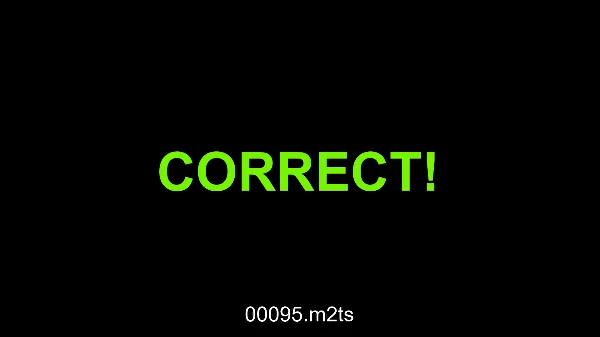
From now on solving this challenge seemed trivial, I just needed to parse all the clips and find what buttons lead to clip 95.
Solving
While the idea was easy enough, I struggled for half an hour trying to parse the clips.
I tried a bunch of libraries to parse the clips and extract the bytecode from them. However, none of them worked, so I decided I should just do it myself.
I grabbed the Call Object instruction opcode (21820000)
and searched for it in HxD across the entire ISO.
I ended up in the same m2ts files where I got a lot of occurrences. I assumed that this bytecode is indeed stored in the same file as the stream itself, so I should parse it directly from those files

When assembled, this instruction looks like this:
>───────┐ ┌───────┐ ┌───────> │
2182 0000 0000 0030 0000 0000 │ !......0....
│ │ │
2182──────│─────────│───────────────────────── Opcode
30────────│───────────────────────── Operand 1
00──────────────────────── Operand 2Let’s write all of these as the constants for the solver
OPCODE_SIZE: int = 4
OPERAND_SIZE: int = 4
INSN_SIZE = OPCODE_SIZE + (OPERAND_SIZE * 2)
CALL_OBJECT = b'\x21\x82\x00\x00' # Call Object {DST}After that, I iterated over the first 47 streams and extracted their buttons.
# Returns { button_id: jmp_to }
def parse_buttons(mnu_data: bytes) -> dict[int, int]:
result = dict()
i = 0
start_off = 0
while True:
# Searching for `Call Object` opcode
s = mnu_data.find(CALL_OBJECT, start_off)
if s == -1:
break
# Move next iter
start_off = s + INSN_SIZE
# Read the current chunk and extract op1 from it
chunk = mnu_data[s:s + INSN_SIZE]
op1 = int.from_bytes(chunk[4:8], 'big')
# Save the dst
result[i] = op1
i += 1
return result
# menu index -> buttons from `parse_buttons`
menus: dict[int, dict[int, int]] = dict()
for menu in p2.iterdir():
menu_id = int(menu.name.split('.')[0])
if menu_id > 47:
break
with open(menu, 'rb') as f:
content = f.read()
menus[menu_id] = parse_buttons(content)At this point, I already had all the playlists and parsed buttons from these playlists. To make the other logic a bit easier to implement, I collected all the successors and predecessors for menus into separate dicts.
# menu index -> possible exits
menus_possibilities: dict[int, list[int]] = dict()
# menu index -> { jmp_dst: [buttons] }
menus_referrers: dict[int, dict[int, list[int]]] = dict()
for key in sorted(menus.keys()):
value = menus[key]
menus_possibilities[key] = list()
menus_referrers[key] = dict()
for k, possible_value in value.items():
if possible_value not in menus_referrers[key]:
menus_referrers[key][possible_value] = list()
menus_referrers[key][possible_value].append(k)
if possible_value in menus_possibilities[key]:
continue
menus_possibilities[key].append(possible_value)Now, the solution to this challenge is basically a path from menu 0 to menu 95:
# menu -> button
path: dict[int, int] = dict()
for k, v in menus_possibilities.items():
tgt = None
# Selecting the first menu that id is <=47 (or 95)
for possible_move in v:
if possible_move > 47 and possible_move != 95:
continue
tgt = possible_move
break
if not tgt:
print('[!] Unknown tgt?!')
break
path[k] = menus_referrers[k][tgt][0]
print('[+] Menu:', k, 'Button:', path[k], 'Next:', tgt)Looking at the output below, I tried to guess what alphabet I needed to use to convert these numbers to characters.
[+] Menu: 0 Button: 21 Next: 1
[+] Menu: 1 Button: 12 Next: 2
[+] Menu: 2 Button: 32 Next: 3
[+] Menu: 3 Button: 32 Next: 4
[+] Menu: 4 Button: 18 Next: 5
[+] Menu: 5 Button: 35 Next: 6
[+] Menu: 6 Button: 29 Next: 7
...The first button that I should click on is 21.
Knowing that the flag starts with SECCON{, I know that the first char is S with ID 21.
I looked at the button layout to decode the alphabet:
1 2 3 4 5 6 7 8 9 0
Q W E R T Y U I O P
A S D F G H J K L {
Z X C V B N M _ - }And oh well, when I concatenated it to a single string 1234567890QWERTYUIOPASDFGHJKL{ZXCVBNM_-}
and searched for S there, I got:
>>> '1234567890QWERTYUIOPASDFGHJKL{ZXCVBNM_-}'.find('S')
21
>>>All I had left to do is to just grab all the button IDs and convert them to characters using this alphabet:
ALPHABET = '1234567890QWERTYUIOPASDFGHJKL{ZXCVBNM_-}'
FLAG: str = ''
for k, v in path.items():
if v >= len(ALPHABET):
break
FLAG += ALPHABET[v]
print('[+] Flag:', FLAG)Which finally produced the flag.
Flag
SECCON{JWBH-58EL-QWRL-CLSW-UFRI-XUY3-YHKK-KFBV}
Full solver source
from pathlib import Path
p2 = Path(__file__).parent / 'menus'
# p2 = Path('F:\\BDMV\\STREAM')
"""
95 - win
96 - lose
"""
# DST - first operand
# SRC - second operand
# in bytes
OPCODE_SIZE: int = 4
OPERAND_SIZE: int = 4
INSN_SIZE = OPCODE_SIZE + (OPERAND_SIZE * 2)
BIT_CLEAR = b'\x50\x40\x00\x0D' # Bit Clear GPR{DST}, {SRC}
CALL_OBJECT = b'\x21\x82\x00\x00' # Call Object {DST}
# Returns { button_id: jmp_to }
def parse_buttons(mnu_data: bytes) -> dict[int, int]:
result = dict()
i = 0
start_off = 0
while True:
s = mnu_data.find(CALL_OBJECT, start_off)
if s == -1:
break
start_off = s + INSN_SIZE
chunk = mnu_data[s:s + INSN_SIZE]
# opcode = int.from_bytes(chunk[:4], 'big')
op1 = int.from_bytes(chunk[4:8], 'big')
# op2 = int.from_bytes(chunk[8:], 'big')
# print('[+] i =', i, 'CALL_OBJECT', op1, op2)
result[i] = op1
i += 1
return result
# menu index -> buttons from `parse_buttons`
menus: dict[int, dict[int, int]] = dict()
for menu in p2.iterdir():
menu_id = int(menu.name.split('.')[0])
if menu_id > 47:
break
with open(menu, 'rb') as f:
content = f.read()
menus[menu_id] = parse_buttons(content)
# menu index -> possible exits
menus_possibilities: dict[int, list[int]] = dict()
# menu index -> { jmp_dst: [buttons] }
menus_referrers: dict[int, dict[int, list[int]]] = dict()
for key in sorted(menus.keys()):
value = menus[key]
menus_possibilities[key] = list()
menus_referrers[key] = dict()
for k, possible_value in value.items():
if possible_value not in menus_referrers[key]:
menus_referrers[key][possible_value] = list()
menus_referrers[key][possible_value].append(k)
if possible_value in menus_possibilities[key]:
continue
menus_possibilities[key].append(possible_value)
# menu -> button
path: dict[int, int] = dict()
for k, v in menus_possibilities.items():
tgt = None
# Selecting the first menu that id is <=47 (or 95)
for possible_move in v:
if (possible_move > 47 and possible_move != 95) or possible_move == 0:
continue
if tgt:
print('[!] What should i choose master', tgt, possible_move)
tgt = possible_move
if not tgt:
print('[!] Unknown tgt?!')
break
path[k] = menus_referrers[k][tgt][0]
print('[+] Menu:', k, 'Button:', path[k], 'Next:', tgt)
ALPHABET = '1234567890QWERTYUIOPASDFGHJKL{ZXCVBNM_-}'
FLAG: str = ''
for k, v in path.items():
if v >= len(ALPHABET):
break
FLAG += ALPHABET[v]
print('[+] Flag:', FLAG)